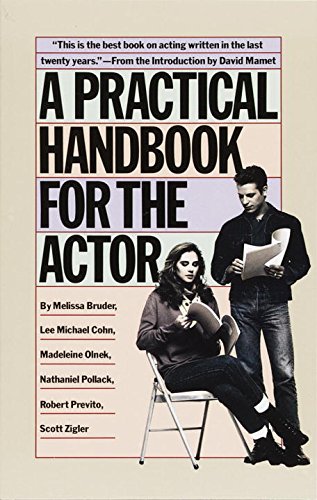One of the books I have in San Miguel is A Practical Handbook for the Actor, by Bruder, Cohn, Olnek and Pollack. It was a useful book to consult when writing about actors in The Shadow Queen, but it’s now and again also mentioned as a useful book for writers. This morning, I scanned through it, before returning it to the shelf.
It’s true that many of the passages are relevant to writing. I especially like this one, for example:
The only talent you need to act is a talent for working—in other words, the ability to apply yourself in learning the skills that make up the craft of acting.
With writing in mind, it becomes: The only talent you need to write is a talent for working—in other words, the ability to apply yourself in learning the skills that make up the craft of writing.
So true!
Here are some others:
You must understand that acting, like carpentry, is a craft with a definite set of skills and tools. By assiduously applying your will to the acquiring of those skills and tools, you will eventually make them habitual.
It’s as if I …
I found Chapter 2, on Analyzing a Scene, particularly useful. As writers, we “experience” the scene we’re creating. These craft tools for actors are useful for writers as well:
- What is the character literally doing? (i.e. Tackling a man.)
- What is the essential action of what the character is doing in the scene? (The “essential” action is the purpose behind the literal actions, i. e. Physically stopping a horrendous thing from happening.)
- What is that action like to me? It’s as if … (For example, “It’s as if I were trying to stop my baby from being killed.” This third one is key to being able to put yourself emotionally into the character.)
The second step of defining the essential action can have a number of possible answers, and each one will require a different response to the third.
For example, it could go like this:
- What is the character literally doing? (i.e. Tackling a man.)
- What is the essential action of what the character is doing in the scene? (Hoping to get a promotion by proving herself the hero of the hour.)
- What is that action like to me? It’s as if … (“It’s as if I would be fired if I didn’t prove I could do a man’s job.)
Just tell the story!
Here’s another sweet spot:
The crucial thing to remember is that the actor is not on-stage to have an experience or to expose himself to the audience, but to help tell a story.
Converting this to writing: The crucial thing to remember is that the writer is not writing in order to have an experience or to expose himself to the readers, but to help tell a story.
Another bit of advice I like is:
Choose something that makes you really want to act the action you have chosen for the scene. … The better your as-if, the stronger your action, and thus the full strength of your humanity will be brought to the work.
The through-line
The through-line is the one action that all the individual actions serve.
You must decide what your ultimate goal is and then construct each individual action to bring you a step closer to achieving that goal.
That through-line is often difficult to discern when it comes to writing a novel. Margaret Atwood once described it as the skewer running through the meat and veggies that make up a shish kebab. That’s a very useful image to keep top of mind.


